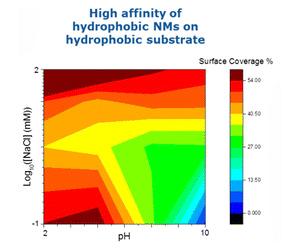
JRC scientists developed and patented a new method for the rapid characterisation of surface hydrophobicity of nanomaterials. This is important for risk/benefit assessment of new materials.
Engineered nanomaterials (NMs) are widely used in a large number of consumer and industrial products and in many healthcare related products such as nanomedicines. The understanding of their interactions with biological systems is of great importance for the assessment of risk and benefit associated with their use. The physico-chemical characterization of the NMs is the first fundamental step for the risk/benefit assessment. Together with the standard NMs physico-chemical parameters (average size, dispersion, surface potential), surface hydrophobicity plays a critical role in various biological processes as well as on the stability and bio-distribution of nanovectors. The development of fast methods for NMs hydrophobicity characterisation would then be of a great interest for NMs and nanomedicine producers providing a meaningful reduction of cost-per-analysis.
The detection platform developed by the JRC is based on the measurement of the affinity between NMs and a fluorinated hydrophobic surface, modified by a layer-by-layer (LBL) deposited polyelectrolyte (PE) in order to tune the surface properties and to allow long range hydrophobic interaction to occur. As a negative control, a hydrophilic surface modified by PE layers is used. The scientists demonstrated that these platforms allow discriminating between hydrophilic and hydrophobic NMs. The determination of the nanomaterial hydrophobic character is carried out by the direct measurement of the affinity of the NMs for different collectors.

Figure: Description of the principle of the developed method: hydrophobic NMs (polystyrene nanoparticles) show large affinity to an engineered hydrophobic surface compared to a hydrophilic one. The study is done as a function of the pH and salt concentration of the NMs dispersion.
Read more in: C. Desmet, et al. "Characterisation of nanomaterial hydrophobicity using engineered surfaces", Journal of Nanoparticle Research 19 (2017) 117-XXX, doi:10.1007/s11051-017-3804-z
A. Valsesia, C. Desmet, P. Colpo, F. Rossi "Screening of nanoparticle properties", Patent application published as WO2016177641 A9
Related Content
Characterisation of nanomaterial hydrophobicity using engineered surfaces
Details
- Publication date
- 11 April 2017
